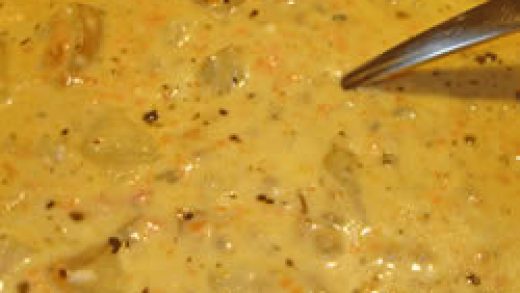Bachelors might wonder why they need to have vinegar in their pantry. “I don’t eat salad all the time,” I hear you say. But vinegar has other uses than salad dressings and cleaning. Not only should you have vinegar, but you should also have at least three different kinds of vinegar for different foods, cooking and dressings. One use I put vinegar too often is as a final kick to a dish before serving. Just a splash of acid, like vinegar or lime juice, can make a big difference in brightening up the taste.
The word vinegar comes from an old French term for sour wine. That’s pretty much what vinegar is. It is created by fermenting ethanol, which makes acetic acid. Old film photographers will notice this is the same main ingredient to what we called Stop Bath, an acid wash to stop the developing process of film or photographic paper. Vinegar can be made from wine, cider, beer or fermented fruit juice.
The vinegar you choose for your kitchen will depend on what you like to eat and what kinds of cooking you do. I actually have four kinds of vinegar in my kitchen, although only two of them I use regularly.
One vinegar I use a lot, especially in cooking, is red wine vinegar. This is a relatively mild acid with many different uses. This is what I use most often to brighten the flavor of cooked foods.
My second vinegar is balsamic. This type is very popular for salad dressings and for use on steamed vegetables. Try splashing a little on cooked broccoli next time and see what it does. It will be a revelation. It has a surprisingly sweet taste along with the typical vinegar tartness. But I have to warn you that not all balsamic is really balsamic. Real balsamic vinegar is made from concentrated white grape juice, usually Trebbiano, and aged for a long time in oak casks, just like fine wine. This real balsamic vinegar is very expensive and often costs more than a bottle of fine wine. But most of the varieties you’ll see in the supermarket are really white grape juice combined with white vinegar, caramel coloring and artificial flavorings. Buy the best you can afford.
My third vinegar is cider vinegar but I don’t use it very often. It has a very sour, harsh flavor and is used most often in pickling and for medicinal purposes. Yes, vinegar is used as medicine to help control high blood sugar in diabetics, lower cholesterol and suppress appetite. It can also be used to fight infections and sterilize hard surfaces.
And then I also have rice vinegar, used a lot in Japanese cooking, especially on rice to make it sticky for sushi. Rice vinegar can come in light or white, red or black varieties.
Distilled vinegar is not really useful for cooking, but it does make a dandy cleaner.
Other kinds of vinegar you might often see are Malt and beer vinegar. Both of these are most commonly found in British cooking. Malt vinegar is the preferred condiment for the English classic of Fish and Chips. It’s usually a light brown color and has a sweet, tangy taste because it is made from an ale brewed from malted barley. Beer vinegar is very similar to malt vinegar and is found in many German restaurants and homes.
What vinegars are made from depends on where you are in the world. In the Middle East, dates or raisins are often used. In Western Europe, you might see honey vinegar. Cane and palm vinegar are common in the Philippines. In Southeast Asia, there’s coconut vinegar. And in China, they make black vinegar from grain.
So, now you know more than you ever wanted to about vinegar. But give some of these a try and see what they can do for food that needs a little perking up. Or if you have a problem overeating, a small shot of vinegar will keep you from wanting all that food. Kinds of vinegar have been around for thousands of years. There has to be a reason.



